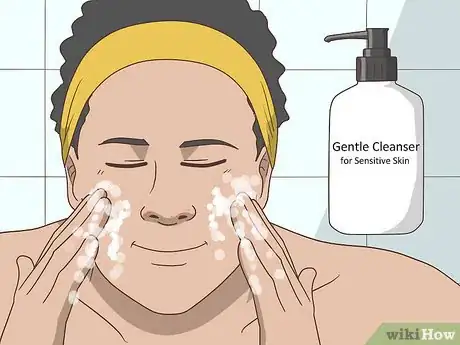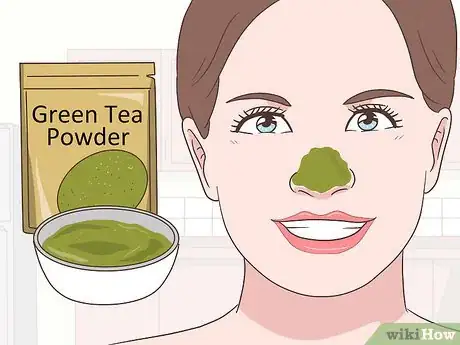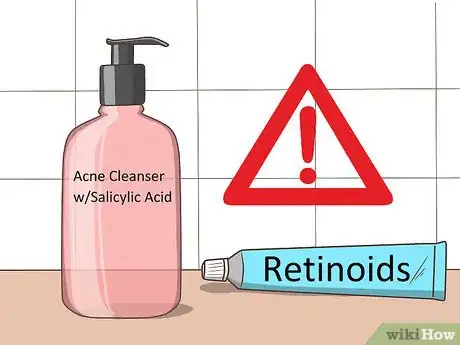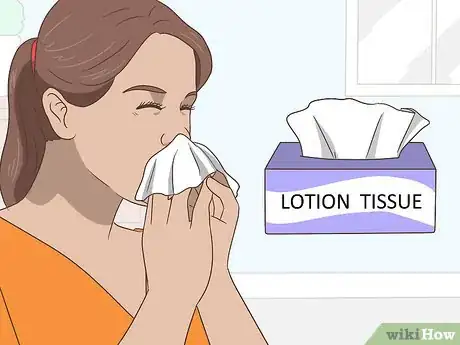This article was medically reviewed by Luba Lee, FNP-BC, MS. Luba Lee, FNP-BC is a Board-Certified Family Nurse Practitioner (FNP) and educator in Tennessee with over a decade of clinical experience. Luba has certifications in Pediatric Advanced Life Support (PALS), Emergency Medicine, Advanced Cardiac Life Support (ACLS), Team Building, and Critical Care Nursing. She received her Master of Science in Nursing (MSN) from the University of Tennessee in 2006.
There are 12 references cited in this article, which can be found at the bottom of the page.
This article has been viewed 195,391 times.
Research suggests that red and irritated skin on your nose is typically caused by skin dryness due to weather, genetics, age, and certain skin or medical conditions.[1] Your skin may even be irritated because you've been wiping your nose with tissue. Experts agree that dry skin is usually treatable with moisturizer and skin treatments.[2] In many cases, you can heal the skin around your nose with self-care. However, visit your doctor if your nose doesn't improve or you notice any sores around it.
Steps
Moisturizing Your Nose
-
1Wash your face daily with a gentle cleanser for sensitive skin. Splash your face with lukewarm water and gently massage a small amount of cleanser into your skin. Rinse it off and pat dry with a soft towel.[3]
- Look for a cleanser made for sensitive skin that includes anti-inflammatory ingredients like calendula and centella asiatica. Avoid cleansers with alcohol or sulfates, which will dry out your skin.
-
2Apply a moisturizer twice a day. After washing your face, rub on a bit of moisturizer. Read the instructions on your brand to see exactly how much to apply, making sure to target the area around your nose in particular. Let your moisturizer dry for 1-2 minutes.[4]
- Look for a moisturizer made for sensitive or irritated skin, ideally containing ceramides or antioxidants like feverfew or licorice extract. For example, you might use Cetaphil Redness Daily Moisturizer or CeraVe Facial Moisturizing Lotion.
Advertisement -
3Try a cucumber mask for added relief. Mix a small amount of water with a few drops of gentle moisturizer. Soak a few cucumber slices in the mixture and place them on the irritated parts of your skin. Repeat a few times a week for extra soothing power.[5]
- The cucumbers will cool your irritated skin, while the moisturizer will help rehydrate it.
-
4Apply a soothing yogurt honey face mask once a week. Grind 1 tablespoon (15 mL) of oatmeal in a coffee grinder for 5-7 seconds. Place it in a bowl and mix in 1 teaspoon (4.9 mL) of honey and 2 teaspoons (9.9 mL) of yogurt until it’s light tan in color and spreadable. Rub it onto your face in circular motions, making sure to cover the irritated skin.[6]
- Grind the oatmeal until it’s fine and grainy, which will make it easier to stir into a paste.
- Leave the mask on for 15-20 minutes, then gently scrub it off.
-
5Apply a green mask to your nose. Green masks contain redness-reducing ingredients like clay, mint, green tea extract, or fruit enzymes. Apply the mask to clean, dry skin. Wait about 15-20 minutes before washing it off. The mask will reduce redness and tighten pores.
- These masks can cause your skin to dry out. Make sure you wash your face and moisturize after using 1.
Treating Nose Dryness
-
1Use a green tea mask to soothe some redness-causing conditions. Mix a bit of green tea powder with water and stir to create a paste. Apply it to the skin around your nose and let it sit for 15-20 minutes, then rinse off.[7]
- Green tea masks are especially helpful for soothing redness caused by rosacea, a skin condition that causes redness, visible blood vessels, and sometimes small bumps on your face.
-
2Ease up on acne products that cause dry skin. Many acne products, including salicylic acid and retinoids, can cause redness and irritation. Stop using these products until your irritation calms down. Then, ease them back into your routine by applying very small amounts every second or third night.
- To fight your acne in the meantime, try at-home clarifying and hydrating tricks like mud masks and Manuka honey.
-
3Apply a warm cloth if your redness was caused by the cold. If the skin around your nose gets flushed and irritated when you’re out in the cold, soak a soft cloth in warm water and lay it on your nose for a few minutes. The warmth will help calm your skin and soothe the irritation.[8]
- Keep your nose warm when you’re out in the cold by wrapping a scarf around your face. Breathing into the fabric will keep a pocket of warm air and moisture around your nose.
-
4Eat healthy fats to keep your skin hydrated. Healthy fats contain omega-3 fatty acids, which strengthen your skin cells and help them stay moisturized. Some healthy fats to incorporate into your diet include avocados, walnuts, and olive oil.[9]
- Avoid spicy foods and alcohol, which can often cause redness.
- Avoid refined and processed carbohydrates. Your body needs more water to digest carbs, pulling it away from your skin and causing dryness and irritation.
-
5Stay hydrated to prevent extra dryness. Dry skin is often caused by general dehydration. Men should drink about 15.5 cups (3.7 L) of water a day, while women should aim for 11.5 cups (2.7 L). Bring a water bottle to work or school and sip from it throughout the day.[10]
- Try adding some flavor to your water with lemon or lime wedges, or slices of cucumber, strawberry, melon, or other fresh fruits and veggies.
-
6See your dermatologist if the redness is persistent. Describe your skin redness and tell your doctor if you’ve tried any home remedies. They will be able to tell you if you have a skin condition and prescribe treatments to clear it up. Some conditions that cause redness include:[11]
- Rosacea, a form of acne that causes redness, irritation, and small bumps.
- Perioral dermatitis, which causes small bumps on a patch of red skin. Your skin might also be scaly.
- Allergies.
Protecting a Chapped Nose when You’re Sick
-
1Blow your nose with lotion-treated tissues to prevent irritation. Look for tissues that have a bit of lotion or even aloe vera on them. These soothing products can help prevent your nose from becoming chapped when you dab or blow it.
- Avoid blowing your nose into rough materials like napkins and paper towels, which will scratch up your nose and make redness and irritation even worse.
-
2Rub petroleum jelly on your nose. Petroleum jelly, like Vaseline or Aquaphor, protects your skin from wind or irritation from tissues. Rub the jelly evenly around the outside of your nose. At the end of the day, you may notice that your issues have started to clear up.[12]
- Don't rub petroleum jelly on the inside of your nostrils, as you may accidentally breathe it in.
-
3Try a DIY steam treatment. Heat up a pot of water until it’s steaming. Place your face 6 inches (15 cm) above the surface and lay a towel over your head and the pot. Breathe in the warm steam for several minutes to soothe your nasal passages and the skin on your nose.
- You can do this several times a day to ease your breathing and help your skin heal.
-
4Use a humidifier at night to keep your skin hydrated. A humidifier will pump a little extra humidity into your room, helping the skin around your nose stay hydrated. You can buy one online or at most home improvement stores.[13]
- Try turning down your heat at night as well. Central heating dries out the air of your home, which can irritate your skin.
- Keep your humidity below 60% in the summer, and between 25%-40% in the winter.
References
- ↑ https://my.clevelandclinic.org/health/diseases/16940-dry-skinitchy-skin
- ↑ https://www.mayoclinic.org/diseases-conditions/dry-skin/diagnosis-treatment/drc-20353891
- ↑ https://www.aad.org/public/diseases/rosacea/triggers/tips
- ↑ https://www.aad.org/public/diseases/rosacea/triggers/tips
- ↑ https://www.mindbodygreen.com/0-12789/5-allnatural-tips-to-get-rid-of-facial-redness.html
- ↑ https://www.youtube.com/watch?v=LXrIGhSr8M8&feature=youtu.be&t=6s
- ↑ https://www.ncbi.nlm.nih.gov/pubmed/23884488
- ↑ https://my.clevelandclinic.org/health/diseases/15439-frostbite
- ↑ https://health.clevelandclinic.org/23-foods-good-skin/
- ↑ https://www.mayoclinic.org/healthy-lifestyle/nutrition-and-healthy-eating/in-depth/water/art-20044256
- ↑ https://www.aad.org/public/everyday-care/skin-care-secrets/face/facial-redness
- ↑ https://www.mayoclinic.org/petroleum-jelly/expert-answers/faq-20057784
- ↑ https://www.washingtonian.com/2012/01/09/the-right-way-to-use-a-humidifier/
About This Article
To get rid of red and irritated skin on your nose, try rubbing some petroleum jelly around the irritated area to protect and soothe your skin. Then, when you blow your nose, use a lotion-treated tissue to prevent chapping. You can also try breathing in warm steam for several minutes to help your skin heal. Next, run a humidifier at night as you sleep to help hydrate the skin around your nose. For a recipe for a nose-soothing cucumber mask from our Medical reviewer, read on!











































































Medical Disclaimer
The content of this article is not intended to be a substitute for professional medical advice, examination, diagnosis, or treatment. You should always contact your doctor or other qualified healthcare professional before starting, changing, or stopping any kind of health treatment.
Read More...